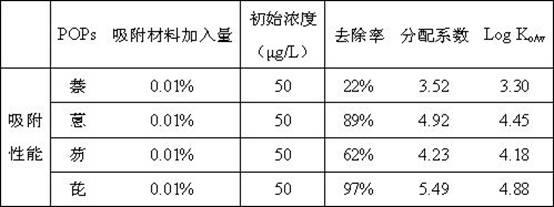Preparation method of absorbing-enriching material for persistent organic pollutants
A technology for organic pollutants and persistence, applied in water pollutants, chemical instruments and methods, adsorption water/sewage treatment, etc., can solve problems such as poor interception capacity, achieve short adsorption time, good adsorption performance, and simple preparation process Effect
- Summary
- Abstract
- Description
- Claims
- Application Information
AI Technical Summary
Problems solved by technology
Method used
Image
Examples
Embodiment 1
[0020] Embodiment 1: material preparation method
[0021] Soluble magnesium nitrate is selected as the skeleton material. Magnesium nitrate plus deionized water was prepared into a solution with a concentration of 0.2 M, sodium silicate plus deionized water was prepared into a solution with a concentration of 0.3 M, and antistatic agent SN was prepared into a solution with a concentration of 0.2 M. Add the antistatic SN solution to the magnesium nitrate solution according to the molar ratio of magnesium nitrate: sodium silicate: SN=1:1.5:1, mix well and then add sodium silicate solution, and the obtained precipitate is washed by centrifugation and then dried for use.
Embodiment 2
[0022] Example 2: Adsorption of persistent organic pollutants
[0023] Add 0.01% SN-magnesium silicate adsorption material to the solutions of naphthalene, anthracene, pyrene and fluorene containing 50 μg / L respectively, mix well, transfer the mixed solution, add cyclohexane liquid-liquid extraction after centrifugation, concentrate and use GC / MS measurement, the measurement data are shown in Table 1. In the case of 0.01% adsorption material addition, the removal rate of persistent organic pollutants can reach 20-100%, and the distribution coefficient in SN-magnesium silicate material is greater than the octanol-water distribution of persistent organic pollutants themselves Coefficient (Log K o / w ), indicating that SN has a good adsorption effect on non-polar persistent organic pollutants. And as the octanol-water partition coefficient of the compound itself increases (i.e. Log K o / w increase) the partition coefficient in the adsorbent material increases.
[0024] Table 1...
Embodiment 3
[0026] Example 3: Adsorption of Polar Organic Compounds
[0027] Prepare a series of 10 mL 10 ~ 140 × 10 -3 mM Acid Green 25 (C.I.61570), Acid Blue 7 (C.I.42080) and Reactive Red 2 (C.I.18200) standard solutions, add 0.01% SN-magnesium silicate adsorption material respectively, mix well and then centrifuge to determine the supernatant Liquid dye concentration. The data results are shown in Table 2. Experiments show that in the case of a small amount of addition, SN-magnesium silicate adsorption material shows better adsorption capacity than other adsorption materials, and the saturated adsorption capacity is between 290-560 mg / g. This shows that the SN-magnesium silicate material is beneficial to the adsorption of polar compounds in persistent organic pollutants.
[0028] Table 2. Adsorption of weakly acidic green GS by SN-magnesium silicate material and comparison with other adsorbents
[0029]
PUM
| Property | Measurement | Unit |
|---|---|---|
| adsorption capacity | aaaaa | aaaaa |
Abstract
Description
Claims
Application Information
 Login to View More
Login to View More - R&D
- Intellectual Property
- Life Sciences
- Materials
- Tech Scout
- Unparalleled Data Quality
- Higher Quality Content
- 60% Fewer Hallucinations
Browse by: Latest US Patents, China's latest patents, Technical Efficacy Thesaurus, Application Domain, Technology Topic, Popular Technical Reports.
© 2025 PatSnap. All rights reserved.Legal|Privacy policy|Modern Slavery Act Transparency Statement|Sitemap|About US| Contact US: help@patsnap.com


